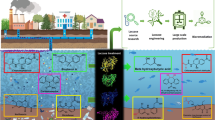Abstract
A mixed community of bacteria from surface runoff waters of the Hyde Park industrial landfill was enriched on 3-chlorobenzoate. Alcaligenes and Pseudomonas species were dominant in the community. Alcaligenes sp. BR60 carried an unstable plasmid specifying 3-chlorobenzoate catabolism. Metabolites detected in culture supernatants included chlorocatechol and chloro-cis,cis-muconic acid. Oxygen uptake in the presence of 3- and 4-substituted methyl-catechols revealed a catechol-1,2-oxygenase activity specific for substituted catechols with very limited activity for catechol. The isolate grew very slowly on benzoate. Alcaligenes sp. BR60 was isolated in co-culture with Pseudomonas fluorescens NR52. The latter contained no detectable plasmids and did not grow on benzoate or any of the chlorobenzoates in pure culture. Growth of the co-culture in Bloody Run Creek water supplemented with 3-chlorobenzoate indicated that phosphate concentrations in the water severely limited biodegradation. Under phosphate limited conditions in continuous culture, Pseudomonas fluorescens NR52 effectively scavenged available phosphate when it was present at a ratio of 1 cell to 20 of Alcaligenes sp. BR60. Under these conditions the growth of Alcaligenes sp. BR60 on 3-chlorobenzoate was reduced 5 fold, the frequency of plasmid deletion mutants increased, and 96% of the contaminant remained in the outflow in the form of the starting material or metabolites. No evidence was found for conjugation of the plasmid determining chlorobenzoate catabolism in Alcaligenes sp. BR60 to P. fluorescens NR52.
Similar content being viewed by others
Abbreviations
- 3 and 4 Cba:
-
chlorobenzoic acid isomers and growth phenotypes
- Ba:
-
benzoic acid
References
Amy PS, Schulke JW, Frazier LM, Seidler RJ (1985) Characterization of aquatic bacteria and cloning of genes specifying partial degradation of 2,4-dichlorophenoxyacetic acid. Appl Environ Microbiol 49:1237–1245
Chatterjee DK, Kellog ST, Hamada S, Chakrabarty AM (1981) Plasmid specifying total degradation of 3-chlorobenzoate by a modified ortho pathway. J Bacteriol 146:639–646
Don RH, Pemberton JM (1981) Properties of six pesticide degradation plasmids isolated from Alcaligenes paradoxus and Alcaligenes eutrophus. J Bacteriol 145:681–686
Don RH, Weightman AJ, Knackmuss H-J, Timmis KN (1985) Transposon mutagenesis and cloning analysis of the pathways for degradation of 2,4-dichlorophenoxyacetic acid and 3-chlorobenzoate in Alcaligenes eutrophus JMP134 (pJP4). J Bacteriol 161:85–90
Dorn E, Knackmuss H-J (1978) Chemical structure and biodegradability of halogenated aromatic compounds: Substituent effects on 1,2-dioxygenation of catechol. Biochem J 174:85–94
Dorn EM, Hellwig M, Reineke W, Knackmuss H-J (1974) Isolation and characterization of a 3-chlorobenzoate degrading Pseudomonad. Arch Microbiol 99:61–70
Fulthorpe RR, Straus NA, Wyndham RC (1988) Bacterial adaptation to chlorobenzoate contamination in the Niagara region investigated by DNA:DNA colony hybridization. Am Soc Testing Materials Spec Tech Publ (in press)
Ghosal D, You I-S, Chatterjee DK, Chakrabarty AM (1985) Microbial degradation of halogenated compounds. Science (USA) 228:135–142
Johnston HW, Briggs GG, Alexander M (1972) Metabolism of 3-chlorobenzoic acid by a Pseudomonad. Soil Biol Biochem 4:187–190
Karns JS, Kilbane JJ, Chatterjee DK, Chakrabarty AM (1984) Microbial biodegradation of 2,4,5-trichlorophenoxyacetic acid and chlorophenols. In: Omenn GS, Hollaender A (eds) Genetic control of environmental pollutants. Plenum Press, New York, pp 3–21
Keil H, Klages V, Lingens F (1981) Degradation of 4-chlorobenzoate by Pseudomonas sp. CBS-3: induction of catabolic enzymes. FEMS Microbiol Lett 10:213–215
King A, Phillips I (1978) The identification of Pseudomonads and related bacteria in a clinical laboratory. J Med Microbiol 11:165–176
Krieg NR, Holt JG (eds) (1984) Bergey's manual of determinative bacteriology, vol 1. Williams and Wilkins, Baltimore, pp 141–199
Kuenen JG, Boonstra J, Schroder HGJ, Veldkamp H (1977) Competition for inorganic substrates among chemoorganotrophic and chemolithotrophic bacteria. Microb Ecol 3:119–130
Parkes RJ (1982) Methods for enriching, isolating and analyzing microbial communities in laboratory systems. In: Bull AT, Slater JH (eds) Microbial interactions and communities, vol 1. Academic Press, Toronto, pp 45–102
Pignatello JJ, Johnson LK, Martinson MM, Carlson RE, Crawford RL, (1985) Response of microflora in outdoor experimental streams to pentachlorophenol: Compartmental contributions. Appl Environ Microbiol 50:127–132
Poole K, Parr TR Jr, Hancock REW (1987) Phosphate selective porins from the outer membranes of fluorescent Pseudomonas sp. Can J Microbiol 33:63–69
Schmidt E, Hellwig M, Knackmuss H-J (1983) Degradation of chlorophenols by a defined mixed microbial community. Appl Environ Microbiol 46:1038–1044
Schraa G, Boone ML, Jetten MSM, van Neerven ARW, Colberg PJ, Zehnder AJB (1986) Degradation of 1,4-dichlorobenzene by Alcaligenes sp. strain A 175. Appl Environ Microbiol 52:1374–1381
Shields MS, Hooper SW, Sayler GS (1985) Plasmid-mediated mineralization of 4-chlorobiphenyl. J Bacteriol 163:882–889
Spain JC, Nishino SF (1987) Degradation of 1,4-dichlorobenzene by a Pseudomonas sp. Appl Environ Microbiol 53:1010–1019
Starr MP, Stolp H, Trüper HG, Balows A, Schlegel HG (eds) (1981) The prokaryotes, vol 1, Springer, Berlin Heidelberg New York, pp 719–741
Steiert JG, Crawford RL (1985) Microbial degradation of chlorinated phenols. Trends Biotech 3:500–505
Wagner ET, Collin RL (1984) Report of the Niagara River toxics committee. Environment Canada, Communications Branch, Regional Director General's Office, Toronto, Canada
Weisshaar M-M, Franklin FCH, Reineke W (1987) Molecular cloning and expression of the 3-chlorobenzoate degrading genes from Pseudomonas sp. B13. J Bacteriol 169:394–402
Wiggins BA, Jones SH, Alexander M (1987) Explanations for the acclimation period preceding the mineralization of organic chemicals in aquatic environments. Appl Environ Microbiol 53:791–796
Wyndham RC (1986) Evolved aniline catabolism in Acinetobacter calcoaceticus during continuous culture of river water. Appl Environ Microbiol 51:781–789
Wyndham RC, Singh RK, Straus NA (1988) Catabolic instability, plasmid gene deletion and recombination in Alcalignes sp. BR60. Arch Microbiol 150:237–243
Ying W, Bonk RR, Lloyd VJ, Sojka SA (1986) Biological treatment of a landfill leachate in sequencing batch reactors. Environ Progress 5:41–50
Author information
Authors and Affiliations
Rights and permissions
About this article
Cite this article
Wyndham, R.C., Straus, N.A. Chlorobenzoate catabolism and interactions between Alcaligenes and Pseudomonas species from Bloody Run Creek. Arch. Microbiol. 150, 230–236 (1988). https://doi.org/10.1007/BF00407785
Received:
Accepted:
Issue Date:
DOI: https://doi.org/10.1007/BF00407785




